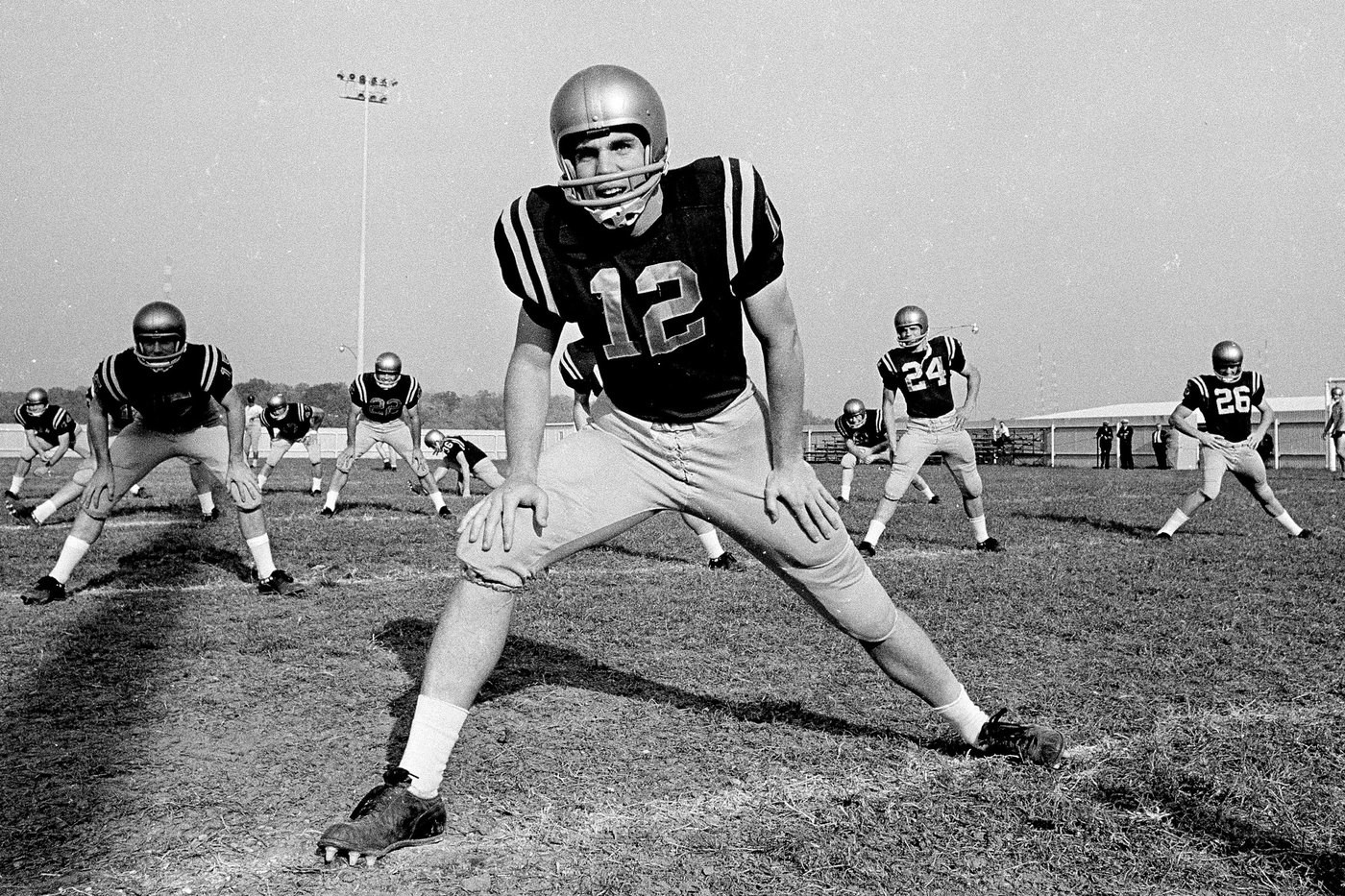
FILE - Navy quarterback Roger Staubach stretches with the rest of the football team in Baltimore, Md., Oct. 22, 1963. (AP Photo/File)
Republished August 14, 2025 - 12:52 PM
Original Publication Date August 14, 2025 - 12:06 PM
A century of Associated Press All-America college football teams features plenty of great teams, great players and a host of of head-scratching quirks, reflecting how the game itself has evolved over 100 years.
Let's start with the most important position: quarterback.
In 1925, when the first AP All-America team was named, the quarterback position did not loom nearly as large. The forward pass had only been legal since 1906 and the required number of yards for a first down had changed from 5 to 10 yards in 1912. The notion of throwing the ball was still in its infancy.
Of the 11 men on the 1925 team, three were listed as “backs” and one as a “running back.” It's not clear why Stanford's Ernie Nevers was labeled a running back.
For the first 45 years, with two exceptions, quarterbacks were simply listed among the backs. For reasons unknown, Northwestern's Otto Graham (1943) and Michigan's Bob Timberlake (1964) were called QBs but Heisman Trophy winners Roger Staubach of Navy (1963) and Steve Spurrier of Florida (1966) were not. Quarterbacks have been specifically designated as such every year since Notre Dame's Joe Theismann in 1970.
Through 1949, the All-America team was made up of 11 players (there were 12 in 1948). A short-lived move to two-platoon football began in 1945 with players no longer required play both offense and defense. The AP began naming 22 All-Americans in 1950.
But in 1953, when one-platoon football returned, it was back to 11 All-Americans. In 1964, there were 22 men on the team even though unlimited substitution didn't return until 1965.
Position titles were kept general into the 1970s, a holdover from those one-platoon days. Backs could be running backs and quarterbacks but also linebackers and defensive backs. Linemen were just linemen. Ends were positioned at the end of the offensive line and were blockers and receivers, or they could be defensive ends.
Specialists weren't recognized until kickers and punters were first honored in 1981, and the first all-purpose player wasn't named until 1991.
Notre Dame is the leader
Since 1925, there have been 1,952 players named to the AP All-America first team. Notre Dame has had the most with 85, followed by Alabama with 83, Ohio State with 79, Southern California with 77 and Oklahoma with 75.
This year's AP All-America team will be released in December.
Where they're from
The state of Texas has produced a nation-leading 255 AP first-team All-Americans through 2024.
The Lone Star State is followed by California with 170, Ohio with 138, Florida with 133 and Pennsylvania with 111.
Houston (33) ranks as the No. 1 hometown for first-team picks followed by Dallas (30), Los Angeles (27), Chicago (26) and Miami (25).
3-time All-Americans
Twelve players earned AP All-America first-team honors three times, a truly elite group that represents fewer than 1% of the 1,949 All-Americans so far. Five played primarily offense and the other seven were on defense:
RBs Felix “Doc” Blanchard and Glenn Davis of Army, 1944-46; B Doak Walker, TCU, 1947-49; LB Richard Wood, Southern California, 1972-74; LB Jerry Robinson, UCLA, 1976-78; DB Kenny Easley, UCLA, 1978-80; DL Hugh Green, Pittsburgh, 1978-80; WR Anthony Carter, Michigan, 1980-82; RB Herschel Walker, Georgia, 1980-82; OL Bill Fralic, Pittsburgh, 1982-84; RB Marshall Faulk, San Diego State, 1991-93; LB James Laurinaitis, Ohio State, 2006-08.
Notable position leaders last 50 years
Over the past half-century (1974-2024), some notable bragging rights:
— BYU leads the nation with four AP first-team All-America quarterbacks honored a total of five times: Marc Wilson (1979), Jim McMahon (1981), Steve Young (1983) and Ty Detmer (1990-91).
— Southern California has the most AP All-America running backs with five players honored seven times: Anthony Davis (1974), Ricky Bell (1975-76), Charles White (1978-79), Marcus Allen (1981) and Reggie Bush (2005).
— Alabama has the most AP All-America linebackers with 12 players honored 14 times: Cornelius Bennett (1986), Derrick Thomas (1988), Keith McCants (1989), DeMeco Ryans (2005), Rolando McClain (2009), Dont’a Hightower (2011), Mark Barron (2011), C.J. Mosley (2012-13), Reggie Ragland (2015), Reuben Foster (2016), Will Anderson Jr. (2021-22) and Dallas Turner (2023).
— Alabama also has the most AP All-America defensive backs with 11 players honored 12 times: Tommy Wilcox (1981), Antonio Langham (1993), Kevin Jackson (1996), Javier Arenas (2009), DeMarcus “Dee” Milliner (2012), Landon Collins (2014), Minkah Fitzpatrick (2016-17), Deionte Thompson (2018), Patrick Surtain II (2020), Kool-Aid McKinstry (2023) and Terrion Arnold (2023).
— Colorado has the most All-America punters with four players honored five times: Barry Helton (1985-86), Keith English (1988), Tom Rouen (1989) and Mark Mariscal (2002).
-- UCLA has the most All-America kickers with four players honored five times: John Lee (1984-85), Bjorn Merten (1993), Justin Medlock (2006) and Ka’imi Fairbairn (2015).
___
Get poll alerts and updates on the AP Top 25 throughout the season. Sign up here. AP college football: https://apnews.com/hub/ap-top-25-college-football-poll and https://apnews.com/hub/college-football
___
This story has been updated to correct the number of BYU All-America QBs and the total number of All-Americans from Texas.
News from © The Associated Press, 2025